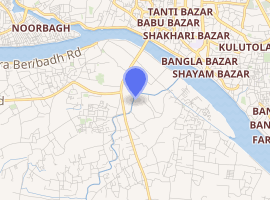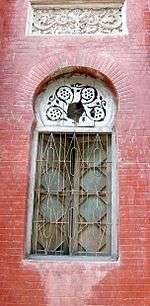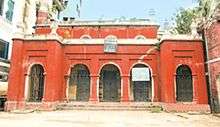Northbrook Hall
Northbrook Hall (also known as Lalkuthi) was originally built as a town hall during the British period. It is situated at Farashgonj road in Old Dhaka, Bangladesh, on the north bank of the Buriganga River.
| Northbrook Hall | |
|---|---|
নর্থব্রুক হল | |
.jpg) Northbrook Hall as seen from the entrance | |

| |
| General information | |
| Town or city | Dhaka |
| Country | Bangladesh |
| Completed | 1880 |
| Owner | Dhaka City Corporation |
History

In 1874, Indian Governor Thomas George Baring, Lord Northbrook, the Viceroy of India between 1872 and 1876, came to visit Dhaka. In order to make his visit memorable, Raja Rai Bahadur, along with eminent Zamidars and affluent citizens of Dhaka, donated 10 thousand and 5 thousand taka each to build the Town Hall in 1879. Abhay Chandra Das was the committee secretary. In 1880, the Commissioner of Dhaka inaugurated it and the personal orchestra of Nawab Abdul Ghani was brought to entertain the commissioner and the guests on inauguration.
On 8 February 1882, a public library was added on the south-east side of the Hall. It was named the Northbrook Public Library and became known for its literary collection. Many books were ruined during the 1971 Liberation War. To re-establish the library, the Maharaja of Tripura donated 1000 TK, the Zamidar of Baliati Brojendro Kumar Roy 1000 TK, Queen Shornomoi 700 TK, Kalikhrishno 500 TK and Bishaishori Devi donated 500 TK. In 1887, the library opened with 1000 books.
A clubhouse was added to the south-side and called Johnson Hall. At Northbrook Hall, Nobel Laureate poet Rabindranath Tagore was honoured by Dhaka Municipality and the People's Association on 7 February 1926. In 1950, Northbrook Hall was used as a telegram office, and later as the Central Women's College. The building is the property of Dhaka Municipality Corporation.[1][2]
Architecture
.jpg)
Northbrook Hall is an Indo-Saracen building, and a fusion of Mughal architecture and European Renaissance architectural styles. The semi-circular horseshoe arches contain the main entrance on the north side. The four octagonal minarets on the north side, along with pinnacles and ornamental parapet, show the Muslim and Mughal features. The windows, doors and walls were ornate, following the European style, but the domes at the top of the building were ornate following the Muslim style.[3]
Current situation

The Buriganga River could be seen from the Northbrook Hall when it was built, but by 1930 the riverfront and the river was obscured. The area lost its importance and residential character and had transformed into a commercial area. In 1998, a government education office was built by the side of Northbrook Hall, part of which is now used by a decorator, and a pentagram fountain in front of the north entrance now completely obscures the view.
Northbrook Hall is one of the protected buildings under the Department of Archaeology. Over the years, several phases of restoration work were undertaken by the Department of Archaeology, in coordination with the Dhaka Municipality Corporation. As the bed on the ornamentations and surface painting on most occasions. However, as the building is more than 130 years old, on few instances, comparatively major restoration building has been actively in use for over a century, only minor restorations were required, especially for the condensation of the plasterwork and paint. The restoration works at Northbrook Hall were more convenient for the Department of Archaeology, as the Dhaka Municipality Corporation actively supported the projects; along with the users, the local community. As there has been no disruption in the use of the building for over a century, the original details of the jalli work and surface ornamentations has survived in very good shape. Also, as the building is actively used and in relatively good shape compared to the other vulnerable heritage, no special fund was required for the conservation (as seen in the other examples like Panamnagar). The users of the building took partial responsibility of the minor restoration works under the supervision of the Department of Archaeology. Northbrook Hall can be considered one of the more successful formal conservation projects undertaken by the Department of Archaeology.
One of the major threats for the heritage building is the encroaching structures, like an assembly hall and a few community canters built surrounding the building. Another critical factor is the 'List of Protected Heritage' published in 2009. Before the list was published, the collaboration between the local community, Dhaka Municipal Corporation and the Department of Archaeology was flexible.[4]
References
- Mamun, M. Dhaka Smriti Bismritir Nagari. Ananya, 1993, pp. 138–139.
- Ahmed, Dr.N Discover The Monuments Of Bangladesh. University Press Limited, 1984, p.212 .
- Ahmed, Dr.N Discover The Monuments Of Bangladesh. University Press Limited, 1984, p. 213.
- IFTEKHAR AHMED, The University of Hong Kong ,p 218-219.
Further reading
- Ahmed, N; John Sanday (1984). Discover The Monuments Of Bangladesh. University Press Limited. ISBN 984-05-1059-2.
- Mamun, M. (June 1984). Dhaka Smriti Bismritir Nagari. Ananya. ISBN 984-412-104-3.
- Ahmed, Iftekhar (January 1984). A Study of Architectural Heritage Management by the Informal Community Bodies in Traditional Neighborhoods of Old Dhaka.